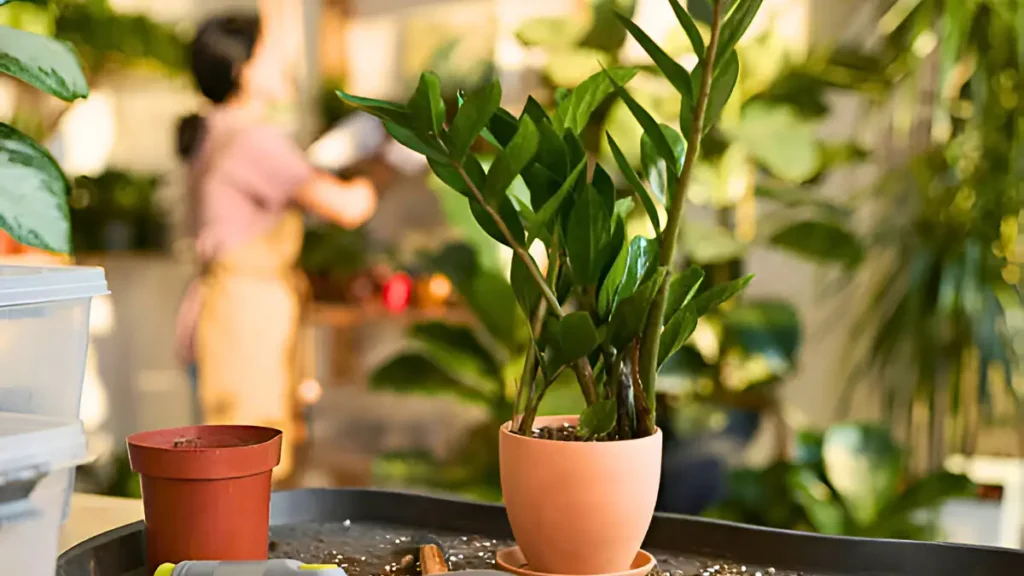For those who are just starting, one of the most popular indoor plants is the ZZ plant (Zamioculcas zamiifolia). It is renowned for being adaptable and requiring little upkeep. Although the ZZ plant was found in the early 1800s, it wasn’t until the 1990s that it was readily accessible as a houseplant. It soon established a reputation for being unbreakable and the ideal houseplant for those who say they are unable to keep houseplants alive. The ZZ plant is native to warm, arid, shaded environments in East and South Africa. It thrives in desert interior environments. Easy to maintain: This houseplant does best in low light from windows facing east or north. Because it stores water in its plump, tuber-like rhizomes and thick, meaty leaves, it is also incredibly drought-tolerant. It expands sporadically and slowly. Everything you need to cultivate a healthy ZZ plant indoors will be covered in this extensive guide, including beginner-friendly care tips and methods.
Knowledge of the natural habitat of the ZZ plant:
Before we get into the details, it’s crucial to understand where the ZZ plant came from. Native to Eastern Africa, the ZZ plant thrives in arid conditions with little water availability. Its adaptability to indoor environments has made it a low-maintenance plant. It can withstand protracted dry spells thanks to the water-storing capacity of its thick, waxy leaves, and its subterranean storage units, or rhizomes, enable it to grow even in low light.
ZZ plant care instructions:
The ZZ plant is regarded as one of the easiest houseplants for novices to care for because it needs little maintenance.
1. ZZ plant light requirements
Because they can adapt so well to different lighting situations, ZZ plants are a common sight in homes and offices. But to promote the healthiest possible growth:
- Ideal light is moderate, indirect light. Low light levels allow the plant to survive, but they will cause it to grow more slowly.
- Don’t leave the plant in the sun for long periods. Its leaves may become scorched in direct sunlight, withering and developing brown patches.
- Don’t worry if your room seems darker! ZZ plants can grow there, but if you want to see rapid development, try putting them in a place with indirect sunshine and bright lighting.
2. How often to water ZZ plant
- After allowing the ZZ plant soil to completely dry out between waterings, deeply water. It should be enough to do this every few weeks, depending on the growing environment. Since a ZZ plant can store water in its rhizomes, it is preferable to submerge it rather than overwater it.
3. ZZ plant soil
- When the soil of the ZZ plant dries up in between waterings, it thrives. Give the plant plenty of water, making sure that any extra runs out completely at the bottom of the pot. Next, before you water it once again, test the soil. Put your finger about an inch into the earth; water the plant well if the soil feels dry to the touch. In a few weeks, inspect the plant again if the soil is still wet. Make use of a potting mix that drains effectively, like one made for cacti or succulents. This lessens the risk of root rot, which is a major problem for ZZ plants in excessively wet environments.
4. The proper temperature and humidity for ZZ Plants
- Room temperatures are kept between 60 and 75°F (16 and 24°C) on average. Zone Zero plants dislike being in extremely cold climates. They can get stressed out by drafts, air conditioners, and heaters, so keep them away from these areas.
- Although they don’t care about humidity, sometimes spraying the leaves can help simulate their natural habitat if you reside in a very dry location. That being said, this is usually not required.
5. Apply fertilizer to your ZZ plant for best development
- Twice a year, use a low-dose liquid fertilizer as directed on the label. Just fertilize it when you remember, and don’t fertilize it again for at least six months. The plant enters a dormant phase in the fall and winter, therefore fertilizer should be avoided during this time as it won’t need additional nutrients.
6. Repotting your ZZ plant
- Every two to three years or when the roots get crowded, repot your ZZ plant. If the roots of the plant are beginning to press against the pot’s edges, you will know it’s getting root-bound. To allow the roots to spread out, choose a container that is 1-2 inches bigger in diameter than the one you are using now. Use clean, well-draining soil during repotting to give the plant the best possible growing environment.
7. How to propagate ZZ plant
Propagation is simple if you want to add more ZZ plants to your collection or give one to a friend:
- Leaf cuttings: Take a healthy leaf off the plant and put it in the ground or water. It should start to generate new rhizomes after a few months.
- Rhizome division: You can divide a plant when repotting by carefully cutting apart the rhizomes. After that, each newly formed segment can be potted independently to create a new ZZ plant.
Conclusion:
The ZZ plant is a great addition to interior spaces for beginners looking to add greenery. It requires minimal maintenance, grows beautifully, and requires careful watering, strong indirect light, and avoidance of overwatering for long-term health.
Certainly! If you’d like to learn more, please consider following our WhatsApp Channel: Harvest Gardening
A frequently asked questions:
Q1: Is ZZ plant lucky at home?
A1: The ZZ plant is believed to bring wealth and good fortune, is popular for its low maintenance requirements and air-purifying capabilities.
Q2: Why is my ZZ plant losing leaves?
A2: It’s possible that overwatering, underwatering, or a lack of light is causing your ZZ plant to lose leaves. Ensure that the plant receives adequate indirect sunlight and that the soil dries out in between waterings.

